How Competent Are We at Competency Education?
CompetencyWorks Blog
Below is the presentation I prepared for the New Hampshire Education Summit on the topic How Competent Are We at Competency Education? (here is link to video)
What a pleasure it is to be here in New Hampshire – the well-spring of competency education. When Susan Patrick, my partner in co-founding CompetencyWorks, and I did the scan of competency education in 2010, we found that there were pockets of competency education across the country. However, there was only one state – and that state was New Hampshire – that had the foresight, courage, and leadership to set a new course for their schools and for their children. Now look at you, setting the course for federal policy by having the courage to imagine a new way for the state and districts to co-design a system of quality assurance – what we used to call state accountability.
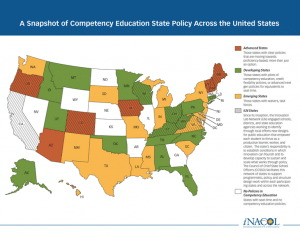
Competency education is spreading across the country. As soon as CompetencyWorks updates this map, we hear of another state taking a step forward. For example, in June, Idaho and Ohio both decided to invest in pilots. However, the thing that convinces me we are going in the right direction is that districts, without the help of any enabling state policy, are converting to competency education – Lindsay in California, Warren and Springdale in Arkansas, Charleston in South Carolina, Henry and Fulton in Georgia, Freeport in Illinois, and Lake County in Florida.

With so many states and districts becoming competency-based, it’s definitely time for us to begin to reflect on how we are doing in converting our time-based system to a competency-based one. It’s time to learn from others so we can make implementation easier with fewer wrong turns. Right now, we don’t have evaluation data to guide us, so we must use the data we do have and, more importantly, be as honest as we can be with each other. We must ask ourselves: How Competent Are We At Competency Education? And what do we need to do better on behalf of our students?
There are so many examples of innovative schools and districts creating personalized, competency-based systems….many of them right here in New Hampshire. However, there are also concerns that we aren’t always getting it right.
Based on what I’ve heard as concerns across the country, from people in New Hampshire and from what I’ve learned from site visits, I’ve identified three areas to focus our attention:
- Schools are putting some elements in place but not pushing themselves to put all the elements into place – thus not getting all the benefits of competency education.
- Sometimes we treat competency education solely as a technical reform, failing to replace the values and assumptions that drive the traditional system with new ones.
- Sometimes we undervalue personalization and student agency. There may be more choice but inadequate investments in helping students to build habits of learning to manage their own education. Personalization and student agency are two sides of the same coin – it’s very difficult to have teachers manage personalized classrooms without students taking on more responsibility for their learning.
For our discussion today, I’ve organized four steps:
Step 1: We will take a moment to focus on our destination – what we want to accomplish and what we need to get there.
Step 2: We will use the five habits of competency education to guide our reflection.
Step 3: We need to be able to identify and diagnose when there are problems and do corrective action. I call these the Red Flags.
Step 4: Our reflection can’t be on just where we need mid-course corrections. We also need to push ourselves to think beyond all the routines, practices, and policies that have shaped what we have known as schools to figure out what we can do better for students. We need to work together to imagine the possible.
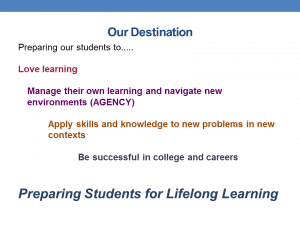
The first thing we need to have is a common understanding of our destination. What do we want to achieve, why is a competency-based system going to help us, and what are its core elements?
What we want is for our students to love learning, to know how they themselves learn, and to be able to navigate and create learning environments that work for them. They need to have the habits of learning to be successful when encountering any new challenge, know how to apply skills and knowledge to new problems in new contexts, and have the skills and knowledge to be successful in college and the workplace. Each community may express this differently, but in the end, what we want is for our students to be prepared for lifelong learning.
We also want to design a system that is personalized enough to ensure students are successful – especially those who have been historically underserved, such as low income students, Native Americans, African-Americans, Latinos, English language learners, and our students with disabilities. We are designing a system in which failure is not an option.
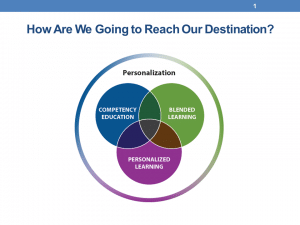
The way we are going to reach our destination is through greater personalization – being able to ensure that students receive the learning opportunities, instruction, and support they need to be successful. I use the phrase personalized system in contrast to describing the traditional system as a factory model. Right now, our best thinking to date is that to create a personalized system, we need to have a competency-based structure, a student-centered approach (sometimes referred as personalized learning) that engages and motivates students to have greater ownership over their education, and then the technology to offer more flexibility in pace, place, and path.
The traditional, time-based system was never designed to ensure equity. In fact, it depended on similar curriculum and amounts of instruction to be able to sort students. In comparison, we are re-engineering to create a personalized, competency-based system to make sure every student is learning every step of the way so they are prepared for the next level of study and the next stage of their life.
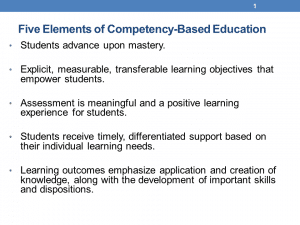
In 2011, 100 innovators in competency education gathered together to create a working definition of competency education. It has five components and ALL FIVE ELEMENTS are NECESSARY.
- Students advance upon demonstrated mastery. This means we need to create the capacity to support students who need more help as well as the ability to let students fly beyond their grade level.
- Explicit, measurable, transferable learning objectives that empower students requires intentionality and transparency. We have to know what we want students to be able to know and do, how we are going to assess, and how we will make sure that students know it.
- Assessment is meaningful and a positive learning experience for students. We want students to be able to fully participate in the cycle of learning by receiving timely feedback. In addition, we challenge the notion that students should take summative exams before they have demonstrated proficiency.
- Students receive timely, differentiated support based on their individual learning needs. This means that students are working in their zone of proximal development and receiving more instructional support when they need it.
- Learning outcomes emphasize application and creation of knowledge, along with the development of important skills and dispositions. This requires us to think broadly about all the skills students need, including habits of learning, as well as ensure we are creating opportunities for students to apply their skills in new contexts. In other words, we need to have the capacity for project-based or real-world learning and performance-based assessments.
When I’ve visited schools where all five of these elements are in place, I have found motivated students, incredibly engaged educators collaborating on how to improve instruction and their skills, and this phenomenal culture of innovation. Ty Cesene of Bronx Arena said it best: We aren’t going to stop innovating until 100% of our students are graduating.
Now let me take a minute to clear up two common misunderstandings.
The first misconception is that competency education is only about pace. The phrase “learning is a constant and time is a variable” has led many to believe that competency-based education is synonymous with online learning. That is wrong. Competency-based education is much more than pace and time – it a structure to ensure that students succeed. Online learning can be incredibly helpful in a competency-based school, but progressing through software or an online curriculum does not necessarily provide transparency, extra support, and opportunities for deeper learning.
Second, some believe that being intentional about what we want students to know and be able to do means that we want all students to end up at the same finishing line. In fact, the opposite is true. Competency education is designed to unleash the potential of every student – a student can be doing eighth grade math and sixth grade reading…and be on a trajectory to take college level math while in high school. They have opportunities to create projects and expanded learning that reflect their interests or allow them to integrate skills they have learned outside of school. We want students to thrive and be all they can be.
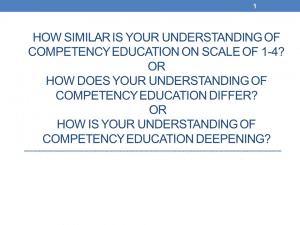
After visiting competency-based schools all over the country, I’ve tried to figure out what makes the difference between those that are able to put competency education in place (where the policies and practices are highly aligned and where students and educators are excited about it) and a really bumpy implementation that continues to hold onto many of the rituals and beliefs of the traditional system, creating a gnawing frustration.
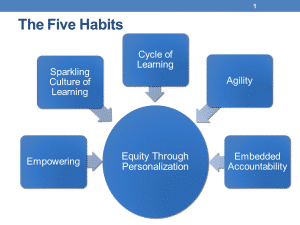
Based on visits to over thirty schools – some more personalized than others, some using technology more than others, some much more innovative in school design than others, and some having real difficulties – I’ve come to think about the five fundamental habits of competency education.
They are: Empowerment, A Sparkling Culture of Learning, Constant Attention to the Cycle of Learning, Agility, and Embedded Accountability. These habits are what we must hold dear, constantly nurturing them. They are the values upon which the system rests.
Let’s explore the first two in detail, as they are essential to effective implementation.

What does it mean to have an empowering system? Moving from the traditional compliance-oriented, top-down system to one that is empowering is an enormous change. To make this change, we need:
- Leadership styles to change. The only way to create an empowered organization is to use adaptive or distributive leadership that is constantly developing leadership in others.
- Students to be more empowered or expected to have agency. In some ways, the traditional system assumes huge amounts of student agency but doesn’t provide any supports to students to develop it. This is one of the ways we continue to create inequity. In competency education, we are going to help students develop the skills they need to be successful learners and have more ability to manage their learning.
- Schools and educators require more autonomy to be able to respond to students. Decision-making needs to shift to be much closer to students.
- There is no doubt that transparency in what we expect to students to learn and in decision-making is a required ingredient in creating an empowering organization.
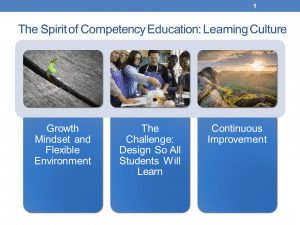
Honestly, I couldn’t figure out the right word to describe the learning culture I see in well-developed competency-based schools. It does sparkle. Students and educators take pride and find joy in learning, including being comfortable talking about mistakes and failures.
One of the hardest things we all have to come to terms with is that the traditional system wasn’t designed around learning – for students or for adults. It really assumes a fixed mindset. We think that some kids are just going to do better than others, whether because of aptitude or because of income.
A competency-based system has to first start with the growth mindset and the understanding of how environment shapes our mindset and our learning. We have to allow ourselves to be challenged by the concept that “all kids can learn.” We all encounter situations where it is hard to imagine how the student is going to learn, and those are exactly the times we have to go ask for help ourselves.
Second, a sparkling culture of learning requires designing so students love learning – by being inquiry-based, motivating, engaging, and doing projects. Learning is fun – it may be really challenging – but it is fun.
Third, the adults all have to commit to continuous learning, both as an organization and in their professional development. Systems will need to be designed so that adults feel supported, recognized, and valued for their learning.
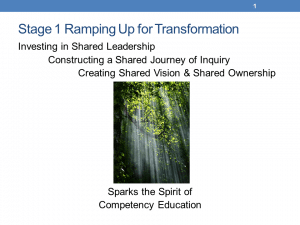
CompetencyWorks released a paper last month on the implementation of competency education. Based on discussion with district and school leaders, we identified four phases. The first phase, Ramping Up for Transformation, is absolutely critically important. It is the stage in which the new capacities are developed to create empowering organizations that can produce sparkling cultures of learning. It is through developing shared leadership in a shared journey of inquiry that we develop the spirit of competency education – empowerment and a love of learning.
I’ve come to believe that if a district or school skimps on the ramping up process, they won’t be able to sweep away the underlying values of the traditional system or build the new habits that will drive the competency-based system. Or as Bob Crumley from Chugach School Districts says…it will come back to bite you.

Let’s take a quick look at the three other habits of competency education.
Nurturing a Cycle of Learning means that educators focus their energy on constantly strengthening their ability for building relationships with students, instruction, and assessment. In the first few years of competency education, teachers start to have much deeper conversations with colleagues about student work, instructional approaches, how they are assessing, and how to assess higher order skills. In some ways, I think we are on the path to the Finnish educational approach in which teachers are the ultimate professionals, taking responsibility for helping students to succeed, but in a uniquely American way.
Agility means significantly increasing the capacity of districts and schools to respond to the changing needs of students. We have been organized to respond to students primarily after they fail. Now we are designing to ensure they are successful. You can call it organizational agility, nimbleness, or responsiveness – it is the heart and soul of designing for equity.
Embedded Accountability (often described as mutual accountability or high reliability) is the capacity to produce success year in and year out. It starts with districts and schools believing that they can and will make sure students are successful. It is creating consistency, such as ensuring that teachers have the same understanding of proficiency so that grading is consistent. It is supported by information management systems that help teachers, principals, and district leaders to move resources around quickly, such as schedules and just-in-time professional development. Bottom line: it is about constantly asking how are our kids doing and what do we need to do to make sure they are successful.
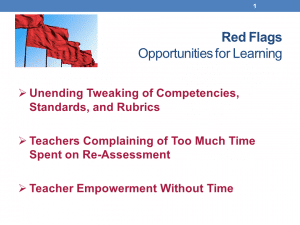
Implementing competency education isn’t the same as introducing a program. There is some complexity in understanding how the five elements and the five habits all form a virtuous system…one designed to consistently help students learn and apply their learning. I’d like to highlight three practices I often see in schools in the first year or two of implementation that are little red flags to me that the five elements and habits aren’t firmly in place.
- When there is unending tweaking of competencies, standards, and rubrics, it often indicates inadequate attention to the culture of learning and the cycle of learning. It may also indicate a bureaucratic approach to supporting teachers rather than a more empowering one. Certainly the technical writing of the standards and rubrics is important, but it needs to be balanced with looking at student work, discussion about what makes it proficient or not, and different instructional approaches to help students better learn the skill. The goal is to calibrate the professional knowledge of teachers, and the competency frameworks are simply supporting tools. Don’t let the tools drive the professional learning of educators.
- When teachers complain of too much time spent on re-assessments, it is a red flag to me that there isn’t enough emphasis on personalization, that students haven’t fully taken responsibility for their learning or may not have developed the habits of learning, and that assessments are not meaningful yet to students in terms of their learning. Why let a student take a summative assessment if they haven’t demonstrated proficiency yet? Do you have rubrics for habits of learning, and are you using them to support students who are learning to manage their time? Do teachers have adequate training for managing personalized classrooms where students may take summative exams at different times?
- When principals tell me that they have empowered teachers but there is little or no time for planning or PLCs, it is a red flag that the habit of empowerment isn’t fully in place. If educators are going to be building their skills, working together to address student needs, they must have the time to talk about students, share student work, and exchange knowledge.
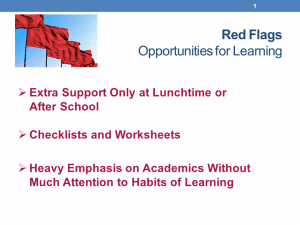
Here are a few more examples of red flags.Why do you think they might be red flags? What elements or habits might need to be strengthened?
1. When extra support is only provided at lunchtime and after school.
2. When instruction is dominated by worksheets.
3. When academic competencies and standards are not balanced with the habits of learning. There may a sign on the wall about the habits of learning, but there is no intentional strategy about how the school will help students develop the habits.
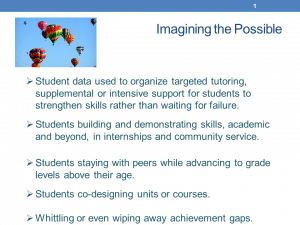
I’m in awe of how difficult it is to think beyond the traditional school year, day, and courses. I am reminded of this constantly as I see information management vendors continually structure their architecture around courses and not students. There are so many aspects of the traditional system, and we all grew up in them, so we have to push ourselves to imagine what is possible – both big and small.
Here are a few examples of practices I’ve seen in schools that help me to push my own thinking. They are small, and they are powerful. Then let’s break again for you to have a few minutes to imagine together.
- I’ve seen schools in New Hampshire using standards to target so students get exactly the help they need. And I’ve seen schools in NYC begin to organize extra preparation for the students they know are entering their school with gaps rather than waiting for them to struggle or experience failure.
- In New Hampshire, with extended learning, students can build and demonstrate skills in all types of projects in the community. It’s interesting to think about why more schools aren’t tapping into that.
- In Maine and in Lindsay, I’ve seen students staying with their cohorts while advancing to much higher levels of study.
- In New York City, I visited a school in which students are helping to co-design courses.
- In New Hampshire and Maine, graduation rates are increasing…and although we haven’t gotten it totally figured out, there are signs that we are whittling away at the achievement gap.
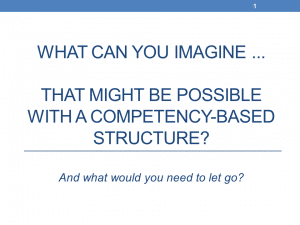
I hope this discussion was helpful. We are all learning and learning from each other. Many of you here in New Hampshire have helped me to better understand competency education, and I am so grateful.
There is always a bit of discomfort when we are learning, but once things get sorted, there is such a warm glowing confidence to be reminded that we can learn and do better by our kids. I feel confident that a school is on the right path whenever I see the question What’s Best for Kids guiding their decision-making.
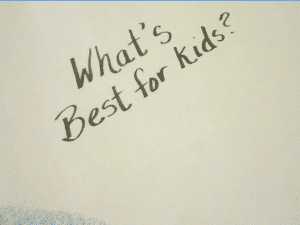
People ask me why I work on competency education rather than the broader next generation learning with all the col technology. There are two reasons. First, without competency education, personalized learning and blended learning are at risk as much as any other reform of not challenging the inequity in our communities and in our system. I think competency education is the best approach for creating an equitable system. Second, the structural changes are hard – they are one half technical and one half values. In my mind, it is the respect, the empowerment, and the belief that we can all grow that inspires me.
And you inspire me. The people of New Hampshire rock. Truly. You are wholeheartedly jumping in to do what’s best for our kids – creating new policies, imagining how to create entire new systems of assessment, and redesigning schools. And you do it with a spirit of collaboration, empowerment, and the love of learning. I thank you…and educators all across the country….thank you.